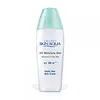What's inside
What's inside
 Key Ingredients
Key Ingredients

 Benefits
Benefits

 Concerns
Concerns

 Ingredients Side-by-side
Ingredients Side-by-side

Water
Skin ConditioningEthylhexyl Methoxycinnamate
UV AbsorberAlcohol
AntimicrobialPropylene Glycol
HumectantDimethicone
EmollientEthylhexyl Triazone
UV AbsorberDiethylamino Hydroxybenzoyl Hexyl Benzoate
UV FilterButylene Glycol
HumectantSodium Dilauramidoglutamide Lysine
HumectantPyrus Cydonia Seed Extract
MaskingGeranium Robertianum Extract
AstringentPhellodendron Amurense Bark Extract
Skin ConditioningSodium Hyaluronate
HumectantAcrylates/C10-30 Alkyl Acrylate Crosspolymer
Emulsion StabilisingCarbomer
Emulsion StabilisingTocopheryl Acetate
AntioxidantSodium Hydroxide
BufferingBHT
AntioxidantMethylparaben
PreservativeWater, Ethylhexyl Methoxycinnamate, Alcohol, Propylene Glycol, Dimethicone, Ethylhexyl Triazone, Diethylamino Hydroxybenzoyl Hexyl Benzoate, Butylene Glycol, Sodium Dilauramidoglutamide Lysine, Pyrus Cydonia Seed Extract, Geranium Robertianum Extract, Phellodendron Amurense Bark Extract, Sodium Hyaluronate, Acrylates/C10-30 Alkyl Acrylate Crosspolymer, Carbomer, Tocopheryl Acetate, Sodium Hydroxide, BHT, Methylparaben
Water
Skin ConditioningEthyl Methoxycinnamate
UV AbsorberMethylene Bis-Benzotriazolyl Tetramethylbutylphenol
UV FilterCyclopentasiloxane
EmollientGlycerin
HumectantEthylhexyl Triazone
UV AbsorberPolysorbate 60
EmulsifyingDiethylamino Hydroxybenzoyl Hexyl Benzoate
UV FilterBetaine
HumectantPhenoxyethanol
PreservativeAmmonium Acryloyldimethyltaurate/Vp Copolymer
Acrylates/C10-30 Alkyl Acrylate Crosspolymer
Emulsion StabilisingHydrogenated Lecithin
EmulsifyingTriethanolamine
BufferingPanthenol
Skin ConditioningDisodium EDTA
Methylparaben
PreservativePropylparaben
PreservativeSodium Hyaluronate
HumectantDipotassium Glycyrrhizate
HumectantSodium Acetylated Hyaluronate
HumectantArginine
MaskingHydrolyzed Collagen
EmollientTetrahexyldecyl Ascorbate
AntioxidantTocopheryl Acetate
AntioxidantWater, Ethyl Methoxycinnamate, Methylene Bis-Benzotriazolyl Tetramethylbutylphenol, Cyclopentasiloxane, Glycerin, Ethylhexyl Triazone, Polysorbate 60, Diethylamino Hydroxybenzoyl Hexyl Benzoate, Betaine, Phenoxyethanol, Ammonium Acryloyldimethyltaurate/Vp Copolymer, Acrylates/C10-30 Alkyl Acrylate Crosspolymer, Hydrogenated Lecithin, Triethanolamine, Panthenol, Disodium EDTA, Methylparaben, Propylparaben, Sodium Hyaluronate, Dipotassium Glycyrrhizate, Sodium Acetylated Hyaluronate, Arginine, Hydrolyzed Collagen, Tetrahexyldecyl Ascorbate, Tocopheryl Acetate
 Reviews
Reviews

Ingredients Explained
These ingredients are found in both products.
Ingredients higher up in an ingredient list are typically present in a larger amount.
Acrylates/C10-30 Alkyl Acrylate Crosspolymer is a synthetic polymer. It is used to thicken and improve the texture of products. Due to its properties, it can prevent water and oil ingredients from separating.
Diethylamino Hydroxybenzoyl Hexyl Benzoate (DHHB) is a chemical UV-A absorber. It is formulated for high UVA protection (320-400 nm).
DHHB is well-liked for:
DHHB has been approved by the EU, Japan, Taiwan, and South America for use up to 10%. Unfortunately, it has not been approved for use in the US or Canada due to slow regulatory processes.
This ingredient is soluble in oils, fats, and lipids.
Learn more about Diethylamino Hydroxybenzoyl Hexyl BenzoateEthylhexyl Triazone is a modern chemical sunscreen that protects from UV-B radiation.
It is the most effective of existing UV-B filters, as it provides the highest level of photo-stable absorption. It protects from the entire UV-B range (280 to 320nm), with it's highest level of protection at 314nm.
Ethylhexyl Triazone is oil soluble, oderless and colorless, which mean it is able to be incorporated into a variety of different formulations.
It is not currently available within the United States due to slow changing FDA regulations. Outside of the US, it is used in formulations at concentrations up to 5%.
Learn more about Ethylhexyl TriazoneMethylparaben is a preservative and is a paraben. It is used to prevent the growth of fungus, mold, and other harmful bacteria. Parabens are chemicals used as preservatives in both cosmetics and food.
Methylparaben can be synthetically created. It can also be found naturally in some fruits, such as blueberries.
Oftentimes, Methylparaben is combined with other parabens to help increase the shelf life.
The safety of Methylparaben is currently being studied. While ongoing studies are looking into the safety of parabens, the results have been very mixed. Some studies have not found Methylparaben to be harmful.
Learn more about MethylparabenSodium Hyaluronate is hyaluronic acid's salt form. It is commonly derived from the sodium salt of hyaluronic acid.
Like hyaluronic acid, it is great at holding water and acts as a humectant. This makes it a great skin hydrating ingredient.
Sodium Hyaluronate is naturally occurring in our bodies and is mostly found in eye fluid and joints.
These are some other common types of Hyaluronic Acid:
Learn more about Sodium HyaluronateTocopheryl Acetate is AKA Vitamin E. It is an antioxidant and protects your skin from free radicals. Free radicals damage the skin by breaking down collagen.
One study found using Tocopheryl Acetate with Vitamin C decreased the number of sunburned cells.
Tocopheryl Acetate is commonly found in both skincare and dietary supplements.
Learn more about Tocopheryl AcetateWater. It's the most common cosmetic ingredient of all. You'll usually see it at the top of ingredient lists, meaning that it makes up the largest part of the product.
So why is it so popular? Water most often acts as a solvent - this means that it helps dissolve other ingredients into the formulation.
You'll also recognize water as that liquid we all need to stay alive. If you see this, drink a glass of water. Stay hydrated!
Learn more about Water